seminar – Thursday 20th October 2016
 Oxidative stress in male reproductive tactics
Oxidative stress in male reproductive tactics
Fabrice Helfenstein, university of Neuchâtel, Swiss
jeudi 20 octobre 2016, 11AM, amphitheatre Monge
In promiscuous species, the subdominant, less attractive males face stronger sperm competition than the subordinate males, and hence are predicted to allocate more resources to ejaculates. Antioxidants can protect sperm against oxidative stress, and thus their allocation to the ejaculate may depend on social status (the oxidation based soma/germline allocation trade-off hypothesis). We have put this hypothesis to the test in two species characterised by medium-to-high levels of sperm competition and with contrasting social systems. In the colonial house sparrow, the linear hierarchy determines mating success with dominant males gaining repeated access to fertile females, and subordinate males being more likely to face sperm competition. In the Seba’s short-tailed bat Carollia perspicillata, males develop alternative reproductive tactics whereby ten percent of the males hold a harem of two to twenty females whilst the other ninety percent of the males occasionally manage to sneak copulations and inescapably face sperm competition.
- kc_data:
- a:8:{i:0;s:0:"";s:4:"mode";s:0:"";s:3:"css";s:0:"";s:9:"max_width";s:0:"";s:7:"classes";s:0:"";s:9:"thumbnail";s:0:"";s:9:"collapsed";s:0:"";s:9:"optimized";s:0:"";}
- kc_raw_content:
 Oxidative stress in male reproductive tactics
Oxidative stress in male reproductive tacticsFabrice Helfenstein, university of Neuchâtel, Swiss
jeudi 20 octobre 2016, 11AM, amphitheatre Monge
In promiscuous species, the subdominant, less attractive males face stronger sperm competition than the subordinate males, and hence are predicted to allocate more resources to ejaculates. Antioxidants can protect sperm against oxidative stress, and thus their allocation to the ejaculate may depend on social status (the oxidation based soma/germline allocation trade-off hypothesis). We have put this hypothesis to the test in two species characterised by medium-to-high levels of sperm competition and with contrasting social systems. In the colonial house sparrow, the linear hierarchy determines mating success with dominant males gaining repeated access to fertile females, and subordinate males being more likely to face sperm competition. In the Seba’s short-tailed bat Carollia perspicillata, males develop alternative reproductive tactics whereby ten percent of the males hold a harem of two to twenty females whilst the other ninety percent of the males occasionally manage to sneak copulations and inescapably face sperm competition.
